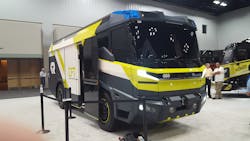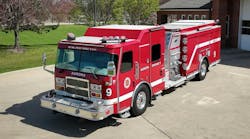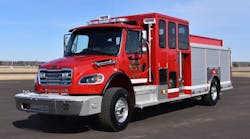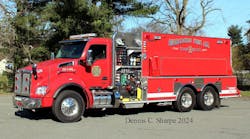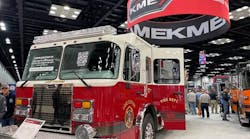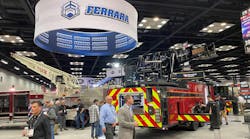It seems the days of the fire service being shy of technology are over, or at the very least waning. Technology was abound at the annual Fire Department Instructor’s Conference in Indianapolis. Cutting-edge technology was displayed in everything from electric-driven fire pumps to flashlights, drones, self-contained breathing apparatus (SCBAs) and even nanotechnology incorporated in PPE and fire hoods.
Harold Boer, president of Rosenbauer America, summed it up well as he commented on a new concept truck his parent company unveiled last week.
“There’s a saying that the fire service is 200 years of tradition uninterrupted by progress,” Boer said. “Well those days are over. We must be ready for the future and the future is now.”
Firehouse staff reviewed many products and talked to those who made them happen. What follows is a report on many of the new items demonstrated and displayed at the conference.
Rosenbauer
For the past five years, Rosenbauer, the world’s largest manufacturer of fire apparatus, has been working on a Concept Fire Truck (CFT). Rosenbauer, headquartered in Austria and the parent company of Rosenbauer America, unveiled that truck in the United States last week.
Boer said the concept truck is a glimpse into what future fire trucks might look like and how they might perform. The new pumper is powered by four electric motors, one at each wheel of the all-wheel drive, all-steer vehicle.
A series of batteries in the futuristic apparatus powers the unit for up to a half-hour to get the apparatus to the scene and then to operate. A diesel-powered auxiliary engine powers the pump and a generator, which can recharge the batteries in 15 minutes.
The cab features seating for eight occupants with two crew seats facing each other on the sides, much like seating found in the back of ambulances.
Rosenbauer said the apparatus is designed to lower emissions and save fuel and provides the same services as engine-driven apparatus while costing about the same as traditional apparatus.
The doors on the unit slide open, much like a bus and it can even kneel like a bus with varying travel heights achieved with suspension technology that allows vertically challenged firefighters access to upper shelves while adjusting to provide high clearance for rough terrain.
Rosenbauer said the company decided to show a lot of the technology that will likely be available soon so potential customers can react to the concept and Rosenbauer can tweak the design to meet customer needs.
Pierce Manufacturing
Pierce introduced a new line of Ascendant aerials that includes a platform aerial, a tiller, and a tandem-axle unit rounding out a single-axle 107-foot aerial introduced in 2015. Pierce’s new Ascendant platform aerial has a reach of 110 feet.
The Ascendant line of aerials use a new weight optimizing design structure that places weight and mass only where required. It also uses 100,000 PSI steel to create a lightweight, yet strong aerial.
“Each configuration takes full advantage of the optimized ladder design and the weight savings we’ve been able to achieve,” said Lisa Barwick, Pierce Manufacturing's director of business development and aerial products. “For example, a tandem rear-axle configuration is over 7,000 pounds lighter, and now satisfies the requirements of weight-restrictive states on the West Coast. Plus, everyone will benefit due to its shorter stopping distances, lower cost of ownership, and enhanced overall vehicle performance.”
All of the Ascendant aerials have tip load capacities of 750 pounds dry and 500 pounds wet with an additional 100-pound allowance for equipment and a 1,500-gpm flow. Other features include an e-coated torque box and stabilizers and an operational range from minus 10 degrees to 77 degrees.
W.L. Gore & Associates
W.L. Gore & Associates introduced the latest in hood technology with a particulate hood designed to block 99.9 percent of particles between 0.1 and 1.0 microns in size while exceeding current NFPA 1971 requirements for thermal protection. The garment is designed to help firefighters avoid exposure to potentially cancer-causing contaminants and provide the same level of protection after 100 wash cycles.
According to Holly Blake, North American product manager in Gore’s Fabrics Division, as the industry learns more about exposure to fireground contaminants, the significance of head-to-toe protection increases.
“Hoods can be a point of vulnerability when it comes to particulate protection,” she said. “We drew on our extensive experience in barrier technology to develop a durable particulate hood. Our feedback from firefighters indicated that it was very important to maintain the natural feel of a traditional hood.
The hood is produced by Majestic Fire Apparel of Lehighton, PA, one of the industry’s leading hood manufacturers.
The new hood uses Gore material as a layer in the hood, which uses thermal protecting face-cloth material for the outer layer. Red stitching alerts the user that the hood is orientated correctly to keep the contaminants off the firefighter’ skin because it can be accidentally turned inside out. It also allows for barrier inspection as well.
Available in two knit options—Ultra C6 (black) and Nomex blend (white)—the GORE Particulate Hood is being sold through Majestic Fire Apparel’s dealers.
Globe
One would not automatically think of technology being incorporated into turnout gear but it is in many ways. Globe introduced vast improvements to its Athletix line of turnout gear.
New material technology allows an athletic design with stretch fabrics for a closer body-contoured fit to provide an unprecedented range of motion with less bulk, more flexibility and lighter weight.
According to Globe, the gear uses new KOMBAT-Stretch using PBI/Kevlar fabric, a new Nomex-Nano thermal barrier material, new 3M Scotchlite Comfort Trim, which is segmented to be lighter and more flexible and breathable without sacrificing visibility.
Rob Freese, senior vice president of manufacturing for Globe, and descendant of the company’s founder, said he has heard from many firefighters that the new turnout gear feels like Carhartt work clothing.
MSA
There’s probably nothing more technologically advanced in the fire service than a firefighter’s SCBA. When one adds an integrated thermal imaging camera (TIC) into the SCBA, it’s truly space age.
But that’s exactly what MSA has done with its G1 Integrated Thermal Imaging Camera (G1 iTIC). The unit, which was previewed last year, earned National Fire Protection Association (NFPA) approval in February and was available for distribution at this year’s show.
The unit is built into the SCBA’s pressure monitor with a camera on the end and a screen in the middle of the monitor that can be easily viewed through the face piece.
Incorporating TIC technology directly into the SCBA provides multiple advantages, such as an auto-on feature that activates the camera once the SCBA is pressurized. Additionally, the TIC is driven by the G1 SCBA’s single integrated power source, which eliminates the need for additional batteries.
Scott Safety
Scott Safety’s booth was filled with new technology including a new EPIC 3 RDI voice amplifier for its line of SCBAs. It allows clear communications in loud environments by working with existing compatible Motorola field radios. It uses Bluetooth communications that allows for easy set up and operation with field radios and remote speaker microphones.
The company also displayed a new Scott Connect Monitor that allows incident commanders to see responder SCBA information in real time. The device allows commanders to see air levels, PASS device statuses and EVAC data. It is designed to complement existing accountability and incident command systems.
In the show booth was a HushAir Connect 7500, the industries’ first 7,500-psi compressor that allows more cylinder fills per charge. It also has new radio frequency identification (RFID) sensing technology, which allows firefighter to better manage cylinders and select how best to fill any SCBA cylinder with minimal user involvement or training.
W.S. Darley
Unmanned Aerial Systems (UAS), aka drones, were on full display in the Darley booth. The Hoverfly, a tethered drone, was attached to a new mini-pumper, simulating how it would work in the field.
According to Darley, the FDNY recently used a Hoverfly Livesky system on an active fire to offer views of the scene.
The UAS solution enables constant power and video connection to firefighters on the ground. Darley has been pursuing drone technology for a few years and has developed a Robotics Business Division, which was established to seek the latest technologies and advancements in the market.
Streamlight
Advanced technology can be found in even the most simple, but necessary items like flashlights. Streamlight introduced its new Vantage 180, a helmet and right-angle multi-function flashlight.
It features the company’s C4 LED technology with high- and low-beam and an articulating head that swivels 180 degrees to aim the beam exactly where needed.
A rear LED tail light changes from white to blue for visibility in heavy smoke. It also has a multi-function clip and hardware to mount the unit to a helmet at the user’s choice.
